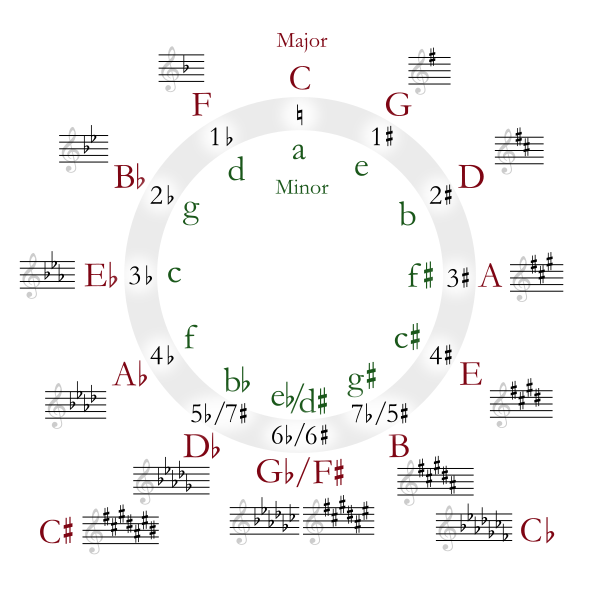Fundamentals of music: week 2
Summary of week 2. Sharps, flats, keys, intervals, other clefs.
Sharps & flats.
We can play major scale starting from any note. When we start from C, we use only white keys on the piano, but that’s not always the case. E.g. if we start from G, we use F# (“F sharp” - one semitone sharper than F). F# can also be denoted as Gb (“G flat”).
Black piano keys (notes) asymmetry (i.e. the fact that not between any two white keys there is a black key) creates landmarks for our ears.
Key
If we use notes from some scale, we say that we are in the key of this scale tonic, e.g. C-maj.
Scale - ordered sequence of notes. Key - relationship, feelings, that pull us back to tonic.
So far we can’t write sharp note on the stave (only white piano keys are represented). There is a way to define sharps as well. One can put sharp sign on a note in the stave (in the beginning) and now all occurrences of that note have to be sharp. Some selections of sharps actually represent a valid key. There is a mnemonic to recognize such keys, called “Circle of fifths”:

Circle of fifths. Author: Just plain Bill (Wikipedia)
Moving by a fifth adds one sharp. Moving by a fourth adds one flat.
Mnemonic for remembering sharps: Father Christmas Gave Dad an Electric Blanket. For flats: Blanket Explodes And Dad Get Cold Feet.
Sample usage - let’s say we see 5 flats. These means that first 5 notes on the left side of the circle (F, B, E, A, D) will be flattened (and this is key of Db).
However, we may want to use non sharp or flat note. We can do this by using accidentals (inlined signs). These can be sharps or flats or a natural (♮, cancels out previous sharps and flats). Accidentals have their effect to the next vertical bar.
Minor keys
Related minor key
Each set of sharps or flats defining a major key, actually defines related minor key.
To find a related minor key tonic, you need to take 6th degree of major scale.
E.g. D maj = D E F# G A B C# D
B is 6th degree, so it is relative minor for D.
We can illustrate this visually in the following way. Let’s plot note frequencies:
This does not give us much, since they grow multiplicatively, let’s do a log plot instead:
Now we see that all notes are uniformly spaced in log space. This means that in log space, a semitone can be represented via a distance on the picture. This allows us to represent a major scale as a template with holes:
The same can be done for Natural Minor and we can see why there is always a related minor to each major at 6th:
Basically when you take 2 major scales together, a natural minor is just a subset of the resulting notes (on the picture A Natural Minor is built using notes from C major).
Similarly B natural minor = B C# D E F# G A B - all notes from D maj, just rearranged (the sequence just starts from B instead of D).
Other kinds of minor scales
There are different types of minor scales. We already saw B natural minor, it still tends into D as a tonic.
B harmonic minor = B C# D E F# G A# B - A# is 7th degree and it leads our ear to B being new tonic. You can get harmonic minor by raising 7th note by semitone in natural minor.
We already know that 1th is called Tonic, 5th - Dominant and now we learned that 7th is called “Leading”.
In harmonic minor there is 1.5 tone jump (from G to A#) and it can be hard for people to sing.
B melodic minor scale - B C# D E F# G# A# B and backward A G F# E D C# B. Backward is same as natural minor. To get melodic minor scale we take natural minor and raise both sixth and seventh notes by a semitone.
Intervals
You define interval by a number and its quality. The number is easy to get, we just count number of notes on a stave from the lowest note to the highest (inclusive). As we already know, we can add sharps and flats to the stave, this won’t affect position of the note, i.e. the number for the interval will stay the same. In order to distinguish such intervals, we define their quality. One cannot determine number or quality of an interval just by counting semitones.
There are 5 qualities - Perfect, Diminished, Augmented, Major and Minor. Unison, fourth, fifth and octave are called perfect and they can be diminished (semitone smaller) or augmented (semitone larger). The remaining intervals (second, third, sixth, seventh) can be major or minor.
Let’s start with perfect ones. We say that an interval is perfect if upper note is in the major key of the lower note. An interval, which is semitone lower than perfect, is called diminished, if semitone higher - augmented.
For seconds, thirds, sixths and seventh - if upper note is in the key of the lower note, we say that interval is major. Semitone lower - minor, semitone higher - augmented
Ledger lines and clefs
We can extend the stave using ledger lines, but this becomes hard to read if you stay there for long time. So there are different clefs to use the stave in different ranges, e.g. bass, alto and tenor. You can combine G clef stave with bass clef stave to get Grand stave. The both staves “meet” at the first ledger line (i.e. middle C).
Here is Grand stave on log plot:
As a mnemonic for other clefs - the center of the sign is always placed at middle C (i.e. C4), e.g. tenor clef:
